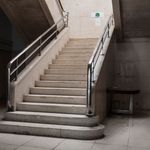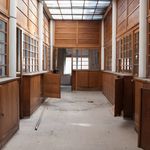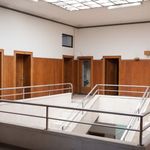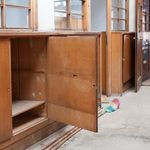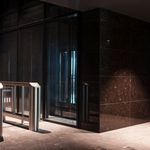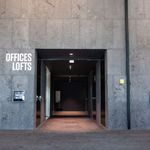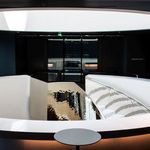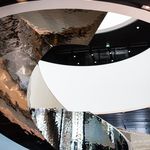Here & There – Places of Absence
Mirjana Rukavina / Here & There – Places of Absence
UGM Studio, Trg Leona Štuklja 2
Opening: Friday, 28. August 2015, at 19:00
An hour before the exhibition opening, at 18:00, the artist Mirjana Rukavina and the curator Simona Vidmar will guide the visitors through the exhibition. The guided tour will be in Slovene. You are kindly invited!
Mirjana Rukavina, a Maribor artist based in Vienna, presents herself at the UGM Studio with a photographic exhibition of two new series that merge into "places of absence". She places Hutter's abandoned textile factory (formerly known as MTT) as an emptied, aestheticised and at the same time traumatised place into a visual dialogue with its alleged antipode − the spectacular Donau City Tower, currently the tallest building in Austria, yet as a designer complex left without traces and apparently perceived as a post-industrial adventure factory. Through their wisely unmasked spatial situations, the two photographic series identify the artist's basic principle of work that shows her absolute distance from her objects of desire by transforming them into a series of documented views. However, the confrontation of two such unexpected feelings of absence, leads us to discover a space that defines and shapes the artist "here and there".
“In the 1950's, Hilla and Bernd Becher started to photograph abandoned industrial architecture. Their photographic series found their way to the art galleries, which left a significant mark on subsequent art photography. (…) Obsolete industrial edifices were a sign of a disappearing, bygone time and yet the Bechers presented it with the aesthetic value of contemporary sculpture. They passed Duchamp's gesture with the pissoir on to photography. An everyday object that otherwise would not attract one's interest, gained artistic value in their photographs, as they do not depict a special scene or event, and the expressiveness is reduced to the mere language of the photographed structure. Only form and a little information about the (former) purpose are recorded without any sentiment. The seriality accentuates the photographers' cold distance holding the position of an objective transmitter of the pictures. (…)
Mirjana Rukavina's exhibition focuses on the current state of a former textile factory site in Maribor's Melje district that was founded by Josip Hutter in 1926, nationalised in 1945, and denationalised and privatised in 1991. The story of the factory which, after it became privatised, gradually but persistently deteriorated is just one of many similar in Maribor, and the artist documented it as a result of the ravages of time in her neighbourhood. Although the scenes in the photographs are presented more or less from an aesthetic view and emotionless, a personal sensitivity in the details can be perceived as well. Traces of people (working gown, wristwatch, and a folder put aside) who long ago enlivened these rooms and used the inventory sensitively span over the emptiness. (…). The former Maribor Textile Factory is a ravage of past times, but as a ruin it has become some kind of a war victim and not a technologically outdated edifice that needs to be recorded, otherwise it would have sunk into oblivion. Although aestheticised, it shows traces of trauma. It is neither beautiful nor spectacular. In some photographs, where there are no utility objects but simply architecture and furniture, the timeless design is appealing and by association tied to another architecture in the exhibition − the new Donau City Tower in Vienna. It too, is an industrial edifice, although not a factory that would produce implements. It is a space dedicated to short-term rentals, and even though it is not empty, it appears impersonal and refined. People leave no traces behind, and the Tower's modular architecture facilitates a quick change of settings and deconstruction. It is a typical space designed for the production and amazement of a modern consumer society that has already forgotten about factories and material production. Most people arrive there only for a couple of hours per year or even only once in a lifetime and can therefore leave the space unburdened. The architecture of the currently tallest building in Austria is an achievement in itself that enthrals or even inspires the attentive observer. However, its functionality is best comparable with an operational system desktop set on our workplace computer. After installing the new version, the old one is easily forgotten. Hutter's factory represents a real body of pain and pleasure; it is a conscious image, a presence, even though fading, while the DC Tower is an apparition not to be grasped and only scarcely perceived through the scenery of spectacle.” (Vasja Nagy)
Maribor-born artist Mirjana Rukavina graduated in Painting at the Academy of Fine Arts in Vienna and in Art Education at the Faculty of Education in Maribor. In the 1990's, her focus of interest shifted from painting to video. Since 2002, she has been largely involved in photography, which often results in spatial installations. She has presented her work at numerous solo and group exhibitions and through video festival participations. As a resident artist, she has worked in Berlin and Vienna where she currently lives and works.
Click here to read more about the Exhibition.
YOU ARE KINDLY INVITED!
Supported by:




